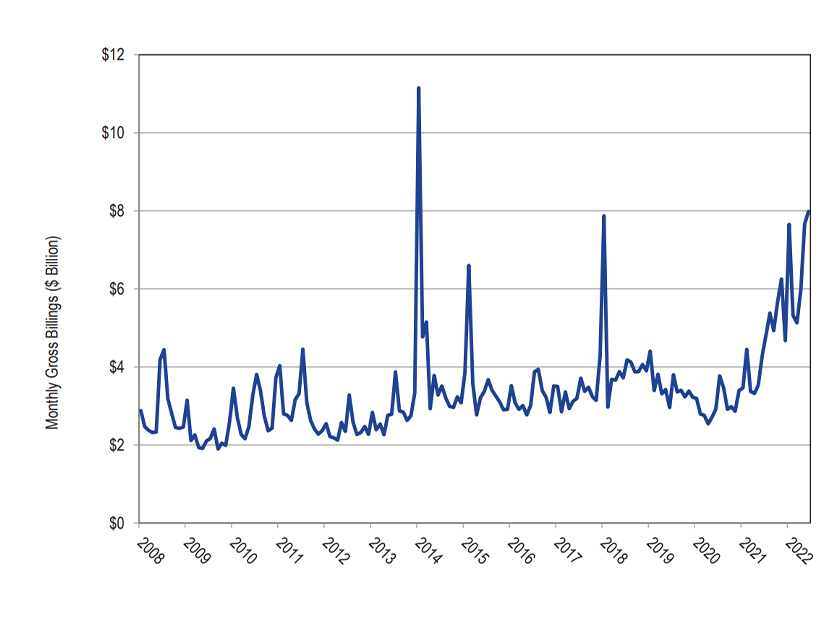
Real-time load-weighted LMPs averaged $67.77/MWh in the first six months of 2022, a 121.3% increase from a year earlier and the largest such spike in the first two quarters since the PJM markets launched in 1999, the Independent Market Monitor reported in its State of the Market report for the second quarter.
The total price of wholesale power increased almost 70% to $95.93/MWh for the first six months of 2022, with energy, capacity and transmission charges representing 98% of the total. Transmission costs per megawatt-hour have exceeded capacity costs since the third quarter of 2019, the Monitor reported.
Almost half of the $37.15/MWh increase was a result of higher fuel and emission costs, with coal and natural gas prices doubling in eastern PJM, the Monitor said. Average real-time loads also were up, increasing by 1.9% to 87,616 MWh.
Congestion costs — LMP price differences resulting from binding transmission constraints — increased by almost $792 million (223.7%) over the same period. Only 31.5% of congestion costs paid by customers for the 2021/22 planning period ending in May was returned to them through the auction revenue rights (ARRs) and self-scheduled financial transmission rights revenues offset, the lowest offset since ARRs were implemented, the Monitor said.
“Congestion belongs to customers and should be returned to customers,” the Monitor said. “The goal of the FTR market design should be to ensure that customers have the rights to 100% of the congestion that customers pay.”
Generation from coal units dropped 6.4% in the first six months of 2022, while natural gas-fired generation increased by 5.2%.
Energy uplift charges increased by $2.8 million (3.6%) in the first half of the year to $82.1 million.
The Monitor offered three new recommendations in the Q2 report:
- PJM, rather than the unit owner, should select the time and day that a unit undergoes net capability verification testing, and the timing should not be communicated in advance to the unit owner. The tests, required to demonstrate that a unit has the installed capacity claimed, are submitted for the summer and winter testing periods. The Monitor also said PJM should require actual seasonal tests and that the ambient conditions under which the tests are performed should be defined. PJM currently permits the use of summer test data adjusted for ambient winter conditions in lieu of actual winter test data.
- If energy efficiency resources remain in the capacity market, PJM should codify eligibility requirements for claiming capacity rights and institute a registration system to track and document such claims. The Monitor contends EE should not be included on the supply side of the capacity market because PJM’s load forecasts now account for future EE.
- PJM should use a nodal approach for distributed energy resources participating in RTO markets. “The PJM market is a nodal market because nodal markets provide efficient price signals to resources in an economically dispatched, security-constrained market,” the Monitor said. “Allowing DER aggregation across nodes is not necessary and would distort market signals indicating where capacity and energy are needed.”


